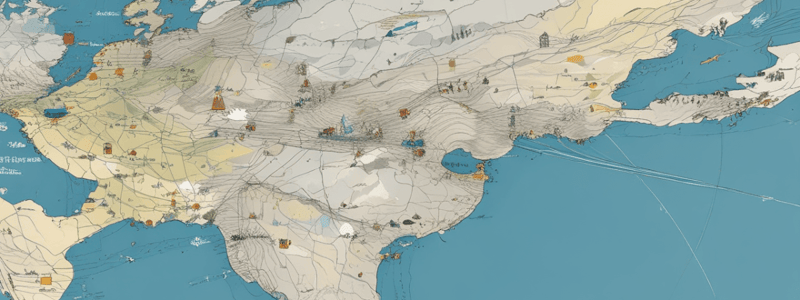Podcast
Questions and Answers
What crucial limitation of in-cockpit NEXRAD systems is highlighted in the content?
What crucial limitation of in-cockpit NEXRAD systems is highlighted in the content?
- They are unable to effectively detect severe icing conditions in flight.
- They may not always provide the most up-to-date weather data due to potential latency. (correct)
- They are susceptible to interference from ground-based weather radars.
- Their accuracy can be affected by the presence of volcanic ash in the atmosphere.
Which of these is NOT a specific example of severe weather information communicated through SIGMETs?
Which of these is NOT a specific example of severe weather information communicated through SIGMETs?
- Regions with severe icing conditions.
- Large-scale thunderstorm activity.
- Dust storms impacting aviation routes.
- Areas with moderate turbulence. (correct)
What is the primary reason for pilots to submit PIREPs?
What is the primary reason for pilots to submit PIREPs?
- To share personal observations and flight experiences with fellow pilots.
- To update ground-based weather radars with real-time conditions.
- To offer valuable insights into in-flight weather conditions that instruments cannot fully capture. (correct)
- To provide supplementary information for pre-flight planning and route selection.
How do PIREPs contribute to a pilot's situational awareness?
How do PIREPs contribute to a pilot's situational awareness?
What is the most effective strategy for mitigating the limitations of in-cockpit NEXRAD systems?
What is the most effective strategy for mitigating the limitations of in-cockpit NEXRAD systems?
Which of these is NOT a recommended strategy for mitigating the limitations of in-cockpit weather display systems?
Which of these is NOT a recommended strategy for mitigating the limitations of in-cockpit weather display systems?
How do SIGMETs contribute to proactive flight planning?
How do SIGMETs contribute to proactive flight planning?
What is the primary difference between a SIGMET and a Convective SIGMET?
What is the primary difference between a SIGMET and a Convective SIGMET?
Which of the following is NOT a significant aspect of pilot weather reports (PIREPs)?
Which of the following is NOT a significant aspect of pilot weather reports (PIREPs)?
What is the primary emphasis of the content concerning in-cockpit weather display systems?
What is the primary emphasis of the content concerning in-cockpit weather display systems?
PIREPs are solely based on ground-based instruments and cannot capture real-world in-flight weather conditions.
PIREPs are solely based on ground-based instruments and cannot capture real-world in-flight weather conditions.
SIGMETs are essential for anticipating severe weather changes during flights.
SIGMETs are essential for anticipating severe weather changes during flights.
In-cockpit NEXRAD systems always present the most current weather data without any limitations.
In-cockpit NEXRAD systems always present the most current weather data without any limitations.
Cross-referencing multiple weather information sources is a strategy to mitigate limitations in weather display systems.
Cross-referencing multiple weather information sources is a strategy to mitigate limitations in weather display systems.
Severe weather phenomena reported by SIGMETs include dust storms and volcanic ash.
Severe weather phenomena reported by SIGMETs include dust storms and volcanic ash.
Analyzing PIREPs can hinder a pilot's situational awareness during flights.
Analyzing PIREPs can hinder a pilot's situational awareness during flights.
A conservative approach is discouraged when planning flights in rapidly changing weather conditions.
A conservative approach is discouraged when planning flights in rapidly changing weather conditions.
Convective phenomena included in SIGMETs can affect multiple flights across extensive areas.
Convective phenomena included in SIGMETs can affect multiple flights across extensive areas.
The course emphasizes the importance of understanding how weather impacts all aspects of aviation.
The course emphasizes the importance of understanding how weather impacts all aspects of aviation.
Icing is not a critical parameter communicated through PIREPs.
Icing is not a critical parameter communicated through PIREPs.
Elaborate on the significance of integrating METARs and TAFs into flight planning, highlighting the specific weather elements they address and how this integration contributes to safe and efficient flight operations.
Elaborate on the significance of integrating METARs and TAFs into flight planning, highlighting the specific weather elements they address and how this integration contributes to safe and efficient flight operations.
Explain the significance of radar imagery in aviation weather services, emphasizing the specific data it provides and how pilots can use this information to enhance flight safety and avoid hazardous weather conditions.
Explain the significance of radar imagery in aviation weather services, emphasizing the specific data it provides and how pilots can use this information to enhance flight safety and avoid hazardous weather conditions.
Discuss the crucial role of weather information in flight operations, highlighting how understanding and integrating METARs, TAFs, and radar imagery contribute to informed decision-making and safe flight practices.
Discuss the crucial role of weather information in flight operations, highlighting how understanding and integrating METARs, TAFs, and radar imagery contribute to informed decision-making and safe flight practices.
Describe how pilots utilize METARs and TAFs to assess the current and future weather conditions at an airport, explaining the specific weather parameters they provide and how this information contributes to flight planning and safety.
Describe how pilots utilize METARs and TAFs to assess the current and future weather conditions at an airport, explaining the specific weather parameters they provide and how this information contributes to flight planning and safety.
Explain how radar imagery, specifically the data on reflectivity and velocity, assists pilots in identifying and avoiding potentially hazardous weather conditions, providing a specific example of how this information can be used in flight planning.
Explain how radar imagery, specifically the data on reflectivity and velocity, assists pilots in identifying and avoiding potentially hazardous weather conditions, providing a specific example of how this information can be used in flight planning.
Discuss the importance of understanding METARs and TAFs beyond simply decoding alphanumeric strings, highlighting how this knowledge contributes to effective flight planning and safe flight operations.
Discuss the importance of understanding METARs and TAFs beyond simply decoding alphanumeric strings, highlighting how this knowledge contributes to effective flight planning and safe flight operations.
Explain how the ability to interpret radar returns, specifically reflectivity and velocity data, can significantly impact a pilot's ability to navigate weather conditions and ensure flight safety.
Explain how the ability to interpret radar returns, specifically reflectivity and velocity data, can significantly impact a pilot's ability to navigate weather conditions and ensure flight safety.
Describe the role of weather information in a pilot's overall decision-making process, emphasizing how METARs, TAFs, and radar imagery contribute to informed choices regarding flight planning, routing, and altitude adjustments.
Describe the role of weather information in a pilot's overall decision-making process, emphasizing how METARs, TAFs, and radar imagery contribute to informed choices regarding flight planning, routing, and altitude adjustments.
Explain how the information provided by METARs and TAFs is crucial for assessing potential weather challenges during flight, and how this understanding contributes to effective flight planning and a safe flight experience.
Explain how the information provided by METARs and TAFs is crucial for assessing potential weather challenges during flight, and how this understanding contributes to effective flight planning and a safe flight experience.
Discuss the importance of synthesizing the knowledge gained about aviation weather services, highlighting how this comprehensive understanding contributes to informed decision-making and safe flight practices.
Discuss the importance of synthesizing the knowledge gained about aviation weather services, highlighting how this comprehensive understanding contributes to informed decision-making and safe flight practices.
Flashcards are hidden until you start studying
Study Notes
Aviation Weather Services Mastery Overview
- Focus on the impact of weather on flight operations throughout the course.
- Emphasis on understanding and utilizing aviation weather reports for improved safety.
Understanding METARs
- METARs are real-time weather observations fundamental for pilots.
- Key elements include wind speed, direction, visibility, and other critical weather conditions.
- Essential for assessing takeoff and landing weather conditions.
Surface Weather Observations
- Offer crucial local weather context with indicators like pressure trends and sky conditions.
- Help pilots predict how weather will influence their flying area, enhancing flight safety and comfort.
Pilot Reports (PIREPs)
- PIREPs provide firsthand accounts of in-flight weather, delivering real-time intelligence on turbulence and icing conditions.
- Learning to interpret PIREPs improves situational awareness and informs decision-making during flights.
Weather Advisories: AIRMETs, SIGMETs, and Convective SIGMETs
- AIRMETs warn about weather phenomena affecting smaller aircraft.
- SIGMETs signal severe weather conditions that can impact all flights.
- Convective SIGMETs specifically alert pilots to active thunderstorms.
- Differentiating between these advisories is crucial for anticipating dangerous weather.
In-Cockpit Weather Display Limitations
- NEXRAD and other weather display systems can suffer from delays and inaccuracies.
- Understanding these limitations prevents reliant blind flying into adverse weather conditions.
- Important to cross-reference multiple weather information sources to enhance safety.
Weather as an Ongoing Challenge and Companion
- Weather must be respected and understood, treated as a constant ally for pilots.
- Neglecting weather details can present formidable risks during flight operations.
Terminal Aerodrome Forecasts (TAFs)
- TAFs are essential for acute flight planning to include upcoming weather changes.
- Provide forecasts on wind direction, speed, visibility, and significant weather phenomena expected within 24 to 30 hours at airports.
Upper Air Data
- Understanding the vertical structure of the atmosphere helps anticipate the weather systems encountered during flight.
Integrating Weather Information
- Combining METARs, TAFs, radar imagery, and PIREPs results in heightened situational awareness and better flight planning.
- Familiarity with SIGMETs and Convective SIGMETs aids in proactive route alterations to avoid severe weather.
Conclusion and Application
- Mastering aviation weather services equips pilots to effectively plan flights and handle unexpected weather changes.
- Importance of continued practice and application of learned concepts in real-world scenarios, ensuring safety and competence in aviation.
Aviation Weather Services Overview
- AIRMETs provide warnings for smaller aircraft regarding significant weather phenomena, while SIGMETs indicate more severe conditions affecting all aircraft.
- Convective SIGMETs specifically highlight active thunderstorms, alerting pilots to avoid these situations for safety.
Weather Interpretation and Tools
- NEXRAD and other in-cockpit weather display systems are essential tools but come with inherent limitations, such as data delays, which necessitate cautious flight planning.
- Understanding the dynamics of weather is crucial for pilots, ensuring preparedness for variable conditions encountered during flights.
Knowledge and Skills Development
- Mastery of Terminal Aerodrome Forecasts (TAFs) is critical for flight planning, as these forecasts detail wind direction, speed, visibility, and significant weather phenomena expected at an airport.
- Familiarity with upper air data enhances awareness of vertical atmospheric structures that influence in-flight weather phenomena.
Pilot Reports (PIREPs)
- PIREPs contain firsthand accounts from pilots about in-flight conditions, such as turbulence and icing, crucial for adapting flight plans based on real-time data.
Flight Safety Considerations
- AIRMET advisories must be interpreted to inform decisions on aircraft performance and flight safety, especially for aircraft with limited capabilities.
- Real-time decision-making is necessary, balancing timely weather updates with in-flight strategy to maintain safety.
Holistic Mastery of Weather Services
- True mastery involves integrating various weather data (METARs, TAFs, radar imagery, PIREPs, and advisories) for informed decision-making and enhanced situational awareness.
- SIGMETs and Convective SIGMETs are vital for predicting severe weather, allowing pilots to adjust routes or delay flights in response to potential hazards.
Limitations of Weather Systems
- Advanced weather display systems can suffer from latency, making it essential to cross-reference multiple data sources for the most current information.
- A conservative flight approach is critical, particularly when dealing with rapidly changing or severe weather conditions.
Conclusion and Future Readiness
- Knowledge gained throughout the course provides a foundation for safe and successful operations in commercial aviation, ensuring pilots are confident in navigating weather challenges.
- Continued practice and application of these concepts in real-world scenarios will solidify understanding and expertise in aviation weather services.
Overview of Aviation Weather Services
- Focus on understanding how weather affects flight operations, emphasizing the importance of weather reports and forecasting.
- Mastery in aviation weather services is crucial for safety and operational efficiency.
METARs and TAFs
- METARs (Meteorological Aerodrome Reports) provide real-time weather observations, essential for assessing current airport conditions.
- TAFs (Terminal Aerodrome Forecasts) offer forecasts for 24-30 hours, helping pilots foresee weather changes that may impact their routes.
- Both METARs and TAFs help identify visibility, wind, precipitation, and cloud cover challenges, allowing for informed flight planning.
Surface Weather Observations
- Surface observations provide context to local weather conditions, highlighting pressure trends and sky conditions.
- Learning to interpret these indicators is critical for anticipating weather's influence on flight safety and comfort.
PIREPs (Pilot Reports)
- PIREPs are firsthand accounts from pilots regarding in-flight weather, offering real-time insights such as turbulence and icing conditions.
- Understanding PIREPs adds a practical layer to interpreting weather data, augmenting the technical knowledge acquired from reports.
Weather Advisories: AIRMETs, SIGMETs, and Convective SIGMETs
- AIRMETs are alerts for weather phenomena affecting all aircraft but particularly critical for smaller aircraft.
- SIGMETs signify severe weather conditions, and Convective SIGMETs specifically indicate active thunderstorms, which require immediate attention and navigation adjustments.
Weather Tools and Limitations
- Familiarity with in-cockpit NEXRAD and weather display systems helps pilots interpret and utilize real-time data while acknowledging their limitations.
- Understanding delays and informational constraints ensures proactive decision-making in the cockpit, avoiding dangerous weather encounters.
Synthesis of Knowledge
- Mastery entails integrating isolated facts into a comprehensive strategy for flight planning and execution.
- Weather services represent vital connections to safer navigation, not just routine checkboxes for pre-flight checks.
Readiness for Future Challenges
- Equipped with a deep understanding of aviation weather services, pilots can confidently tackle atmospheric challenges.
- Ongoing practice in real-world scenarios will solidify the knowledge gained throughout the course, preparing pilots for their careers.
Final Thoughts
- Emphasis on continued education and application of weather-related knowledge for flight safety and operational excellence.
- Maintaining knowledge sharpness is crucial as pilots navigate the complexities of aviation weather.
Studying That Suits You
Use AI to generate personalized quizzes and flashcards to suit your learning preferences.




